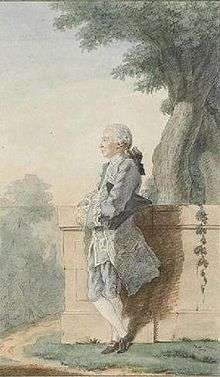Charles-François de Broglie, marquis de Ruffec
| Charles-François de Broglie | |
|---|---|
| marquis de Ruffec | |
 Carmontelle, Count de Broglie, Musée Condé, around 1757 – 1758 | |
| Coat of arms |
 |
| Wife | Louise-Augustine de Montmorency |
|
Issue
Louise 1760-1827 Philippine 1762-1843 Adelaide-Charlotte 1763-1847 | |
| Noble family | House of Broglie |
| Father | François-Marie, duc de Broglie |
| Mother | Thérèse Gillette Locquet de Grandville |
| Born |
August 19, 1719 Paris |
| Died |
August 16, 1781 (aged 61) Saint-Jean-d'Angély |
| Buried | Angouleme Cathedral |
| Religion | Catholic |
| Occupation |
Diplomat Military Officer Head Secret du Roi of Louis XII |
Charles-François de Broglie, marquis de Ruffec[1] (Paris, 19 August 1719 – Saint-Jean-d'Angély, 16 August 1781), was a French soldier and diplomat from an ancient, noble and distinguished French military family (see House of Broglie).
Styled Marquis de Ruffec, he served for some years in the French Army, afterwards becoming one of the foremost diplomats in the service of Louis XV. He is chiefly remembered in connection with the Secret du Roi.[2]
Biography
As second son of François-Marie, duc de Broglie, he was accorded the courtesy title of marquis de Ruffec.
After serving as a French military officer, he was seconded to the diplomatic service of King Louis XV. He served as Ambassador Extraordinary to Poland (1752–56), was recalled at the outbreak of the Seven Years' War, was appointed Chevalier des Ordres du Roi (1757), Lieutenant-General (1760), Commandant of Franche-Comté (1761–62), then after the Peace, Governor of Saumurois (1770). He is best remembered in connection with the Secret du Roi, the private—as distinct from the official—diplomatic service of Louis XV,[3] of which he was the ablest and most important member.[2] He held the post of Premier Colonel of Grenadiers.
The Marquis organized the famous Diner de Metz (8 August 1775), when the young Marquis de La Fayette was convinced by the guest of honour, the visiting Duke of Gloucester, brother of King George III, that the insurgents' revolt in America was in some measure justified. Broglie-Ruffec was involved with Beaumarchais in devising a scheme to offer secret support to the American Revolution in its early stages.[4]
His funeral monument is in the Angouleme Cathedral and a portrait of him, painted by Norman-Michel-Hubert Descours in 1762, is at the Château de Bourdeilles.[5]
Family
He married, 21 March 1759, Louise-Augustine de Montmorency (1735–1817); they had three daughters, Louise 1760-1827; Philippine 1762-1843; and Adelaide-Charlotte 1763-1847.[6]
See also
Notes
- ↑ The seigneurie of Ruffec was sold to him, 6 December 1763, by the heiress of the memoirist Louis de Rouvroy, duc de Saint-Simon, marquis de Ruffec (1675-1755) ("Rouvroy de Saint-Simon")
- 1 2
 One or more of the preceding sentences incorporates text from a publication now in the public domain: Chisholm, Hugh, ed. (1911). "Broglie, de, s.v. Charles François, Comte de Broglie". Encyclopædia Britannica. 4 (11th ed.). Cambridge University Press. p. 626.
One or more of the preceding sentences incorporates text from a publication now in the public domain: Chisholm, Hugh, ed. (1911). "Broglie, de, s.v. Charles François, Comte de Broglie". Encyclopædia Britannica. 4 (11th ed.). Cambridge University Press. p. 626. - ↑ It was suppressed at the accession of Louis XVI.
- ↑ Trentinian 2007 from material in Perrault 1996
- ↑ Patrimoine de France: Bourdeilles This site was down at 14:00, 23 July 2012 (UTC). The most recent WayBackMachine archived copy was here at the Wayback Machine (archived July 21, 2011)
- ↑ Le cimitière virtuel staff 2006.
References
- Perrault, Gilles (1996), Le secret du Roi: La revanche Américaine, Le livre de poche (in French), III, Paris: Fayard, ISBN 9782253144663
- Le cimitière virtuel staff (2006), Charles François DE BROGLIE 20 août 1719 - 16 août 1781 (in French), Le cimitière virtuel, archived from the original on 26 September 2007
- Trentinian, Jacques de (23 September 2007) [2004], The Broglie 'French Connection' and the Planned Invasion of England, xenophongroup.com, retrieved July 2012 Check date values in:
|access-date=(help)